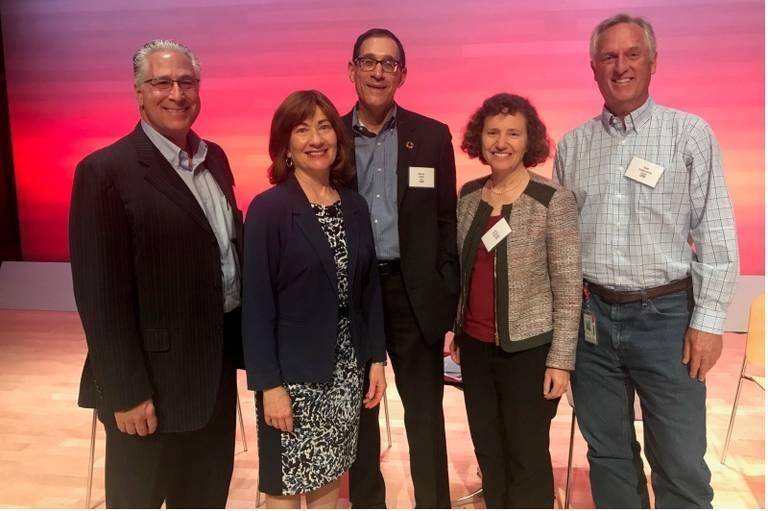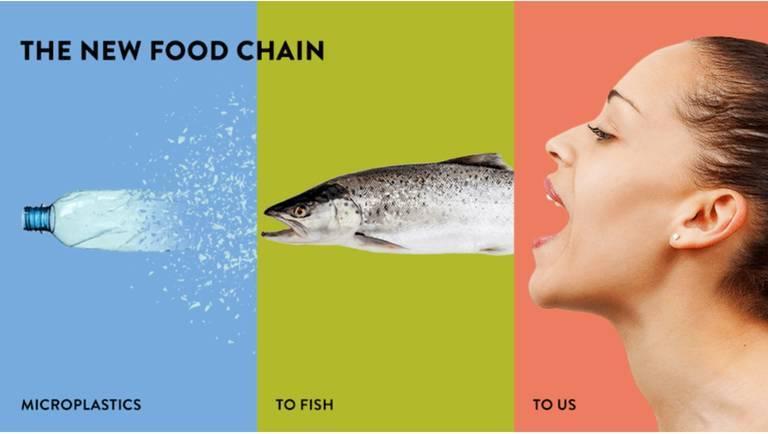Masdar and Norway’s Oil Giant Launch First Battery Storage System Linked to Offshore Wind


A clean energy technology thought to be outrageous just a few years ago may soon become the reality – and profitable. And this development is due to two companies, both from nations that have long been reliant on fossil fuels to power their economies. Now their countries’ marquee energy brands are partnering on technology that could help offshore wind power scale up worldwide.
Last week, Masdar (Abu Dhabi Future Energy Company) and Equinor (former Statoil) announced they have installed a new battery system designed to store electricity generated by Hywind Scotland, which bills itself as the world’s first offshore floating wind farm.
According to Masdar, this battery system, known as “Batwind,” boasts a total storage capacity of 1.2 megawatts, or the equivalent battery capacity of over 1.3 million iPhones. The real value, however, is not simply its energy storage capacity. According to both companies, Batwind’s strength is its ability to smooth out the chaotic peaks and valleys in electricity production, which would optimize the commercial value of Hywind Scotland’s electricity generation. In addition, this project will help evaluate now next-generation battery storage systems can most effectively transmit power from clean energy installations from such plants to local power grids.
“The value in storage is not necessarily in the amount of energy you can store, but how you optimize, control and offer smarter energy solutions. By developing Batwind, we get real time data, commercial experience and technical verification,” said Equinor's Sebastian Bringsvaerd, the company’s development manager for Hywind and Batwind, in a public statement.
For Norway, Batwind is another step in the country’s drive to wean itself from fossil fuels. The country’s sovereign wealth fund announced it would divest from coal companies; the same fund also sued Volkswagen in the aftermath of that automaker’s emissions scandal. Norway’s road to a “greener economy” has not always been smooth; critics have charged that the wealthy Nordic country is simply exporting its carbon emissions. But at the same time, Norway’s citizens have been embracing electric vehicles while its government has been wielding carrots and sticks in urging Brazil’s government to curb forest destruction in the Amazon.
Masdar could also benefit from its investment in Batwind, if a recent IRENA report that suggests the cost to implement battery storage systems could plunge from current levels by two-thirds at the end of the next decade proves to be accurate. As one of several tools in the United Arab Emirates’ kit to diversify its economy in the long term, Masdar has strung together a long trail of clean technology investments. They range from renewables-powered desalination to the launch of clean energy projects worldwide, from the South Pacific to the Indian Ocean to the UAE’s Middle East neighbors such as Jordan. Since Masdar launched in 2006, the company says its investments in renewable energy projects have totaled $8.5 billion.
Image credit: Equinor
Will Carbon Capture Technology Be the New Answer for Energy Production?


There’s been a lot of nay saying when it comes to carbon capture in recent years. The math, let alone the cost associated with such technology seems daunting even to scientists who admit that curbing climate change would likely not be possible without a carbon capture.
Well, planet earth may just be rounding that corner.
Earlier this month, TriplePundit reported that a company in Squamish, British Columbia, Canada had developed a new technology to extract the carbon dioxide from the air and then convert it to fuel. The Air to Fuel technology is considered a first and expected to reduce the cost of carbon capture to just a sixth of what it had been with earlier, antiquated technology.
But Air to Fuel appears to be only one of several ways to capture CO2 from the environment. The Net Power plant in La Porte, Texas has just produced data that suggests that it may be possible to capture carbon as part of the combustion cycle in natural gas production and do so at a fraction of the cost, as well.
The Allam Cycle – the technology behind Net Power’s strategy – is designed to overcome a basic shortcoming in conventional carbon capture: the stand-alone, or “parasitic” carbon capture facility, which takes more room and more energy to accomplish.
The Net Power system uses “a high pressure, highly recuperative, oxyfuel, supercritical CO2 cycle that makes carbon capture part of the core power generation process, rather than an add-on,” explains Rodney J. Allam, who invented the process.” Pretty heady stuff. The result, he says, is a system that produces “a pipeline quality CO2 product at no cost to the system’s performance.”
Allam goes into greater detail of how the technology works in his article for Modern Power Systems, but the takeaway is that carbon capture is quickly excelling as a science that may one day circumvent the need for today’s sprawling, emission-heavy petroleum plants.
Net Power’s selling point isn’t just its technology, but what it takes to run that system. It cuts water usage significantly. According to the U.S. Geological Society, power production accounts for more than 40 percent of the water withdrawals from fresh water and surface water sources combined.
It also reduces the physical footprint. It takes less to operate a smaller plant for a greater output.
The Allam Cycle and Air to Fuel technology are surprising developments in light of last year’s disappointing failure of a Dutch “clean coal” plant, which has helped to sour optimism toward an economical carbon capture system in Europe. Despite the European Union’s historic support of clean energy, carbon sequester technology fails to muster the attention it received a decade ago when the EU enthusiastically backed a series of proposed sites for clean energy production.
At this early juncture, neither Net Power or Carbon Engineering have proven that the their propriety methods can actually take on the burden of national, let alone, global power production. As promising as the new findings sound, the real proof in their success will be how they can transform not energy, but whole communities.
Flickr image: Vikramdeep Sidhu
New Polymer Ups the Ante for Recycling


A team of chemists have produced a polymer that apparently has all the benefits of today’s plastic but can be recycled an immeasurable number of times.
If businesses, particularly manufacturers, can replace plastic with the polymer, one of the world’s most severe pollution problems could be minimized or halted.
A team at Colorado State University say their new product can be made in a relatively environmentally harmless way.
The material’s molecules can be turned into polymer at room temperature in only a few minutes with the use of small amounts of a catalyst, but no solvents. The polymer is lightweight, heat-resistant, strong and durable, just like a conventional plastic.
The first big difference, however, is that it is far easier to recycle than plastic, which requires toxic chemicals and complicated procedures. The material breaks down into its molecular state through a reaction with a catalyst and can be re-polymerized without having to be purified.
The second difference is that the law of diminishing returns does not apply as it does to plastic because the recycling process can be performed time and time again.
The Colorado researchers expect their discovery to confer enormous ethical and environmental benefits. Products made from the polymer would pass through the hands of industry, the retail sector and customers – but would have to be recycled and not placed in landfill holes or thrown into the oceans.
The ideal result would be that the plastic in use today would be banished and would no longer pose a threat to the planet.
The team will now investigate other ways to synthesize the polymer and will work on methods of ensuring that after use the material goes to recycling centers.
This product follows an earlier version that researchers found was soft, had poor heat resistance and had to be manufactured under extremely cold conditions.
Professor Eugene Chen, the lead researcher, said: “The polymers can be chemically recycled and reused, in principle infinitely. It would be a dream to see this chemically recyclable polymer technology materialize in the marketplace.”
Photo: Colorado State University
When You Walk the Talk, Your Footsteps are Louder Than Your Words


By John Friedman
Your core values are not the ones printed in posters on the wall. They are not the ones enshrined in your foundational documents. Your real core values are those that people bring with them - and apply - every day in countless small but meaningful ways every day. Those are the real values that drive decision-making, and therefore your organizational culture.
In fact, I have often noted that organizations that post them the largest, speak about them the loudest end up betraying them in a myriad of ways. No, I am not going to name names (that might get me in trouble) but think back about organizations where you have worked, or done business or used as a supplier.
When an organization says it is dedicated to something - let us say customer service as a simple example - it is not hard to determine if that is really true; or just something that they say. When someone delivers a substandard product (or service) how is their service recovery? [Note I say ‘service recovery’ because anyone can make a mistake or have a bad day.] However, how THEY respond tells you how they really feel about the situation. Do they take ownership or try to deflect? Are then honest and transparent.
I once stayed in a hotel … the location does not matter … and my computer was stolen from my room. Despite the fact that I had in my possession both of the card keys, the manager - who looked at the log and could confirm someone had entered my room twice in my absence using a key card - refused to accept the idea that it was someone operating inside their hotel (the room was on a high floor). He insisted that this had never happened before and intimated that I had lent my key to someone else who had robbed me, but that I was now embarrassed to admit that I had done so.
So, I asked him to call the police. He told me to go fill out a form in person. So, angrily I went and did just that. During the course of the time I was fortunate enough to meet a very kind officer casually mentioned that this was the fourth incident in the same hotel.
When the officer went back with me to the hotel - shocking the manager - the confrontation became rather humorous; and the police officer was able to get the manager to repeat the same lie that he had earlier told me. I started to get angry when the officer stopped me and said - in English for the benefit of this traveler who was not fluent in the local language - ‘Don’t worry. You know, I know and HE knows who is lying.’I insisted on filling out a police report (it was a company computer and I needed one for insurance). That’s when the hotel manager suddenly changed his tune. [The police told me most people do not bother once they know they will not likely get their property back.]
Faced with losing not just my business but also my entire company’s corporate account he tried - in earnest - proving that their core value was not the individual (whom they never expected to see again) but their corporate accounts.
On the other hand, a person barely speaking the language who was not able to articulate well what had happened (or that he was a regular visitor) saw the values of the police in full display. By taking the word of a stranger; ‘The person who comes to fill out a complaint, in the rain on a Sunday and waits 2 hours for someone who speaks their language is the one telling the truth.’
One could make a rightful argument that the core values of the police should include service to others - but the point here is that the values on display - in actions - speak more than words. No matter how loudly or often one shouts them.
Photo: Flickr creative commons 2.0
Looking Past Linear: Making Progress Towards Circular Economy Goals


Panelists for “Designing a More Sustainable Future: Vision, Progress, and Roadmap for Eco-Design and the Circular Economy”
By Pamela Gordon
If you live in Northern California and have time to attend only one sustainability conference each year, then I recommend choosing the Silicon Valley Leadership Group’s (SVLG) Energy and Sustainability Summit, held each year at Oracle’s headquarters in Redwood City. The Summit draws both corporate and governmental leaders who are driving innovative and wide-reaching environmental, social, transportation, and policy initiatives–-including the future of meaningful work, the end of the internal combustion engine, and the rise of distributed energy.
Bringing Circular Economy to Life
That’s why I was particularly pleased when the SVLG invited me to lead a panel presentation on eco-design and the Circular Economy at the May 2018 Energy and Sustainability Summit. I assembled a panel comprising sustainability thought leaders at Flex, HP, Oracle, and Surplus Service to discuss “Vision, Progress, and Roadmap for Eco-Design and the Circular Economy.”
Using diverse real-world case studies, we wanted the audience to readily understand how the Circular Economy’s product design, material sources, logistics, and business models are different from today’s linear economy, and motivate them to progress along the roadmap toward circularity.
Insights into Corporate Circularity Initiatives
I tapped audience volunteers to extemporaneously act out and discern the linear and circular economies, then introduced the panelists and their case studies.
Thomas Calderwood, Director of Reverse Supply-Chain for Oracle, outlined how Oracle develops and manages an entire portfolio of different material sources and channels for reuse, while recycling any materials that fall out. He encouraged companies to take the long view, considering what customers will do with their product years after purchase, and clarified that sustainability is never “someone else’s job,” as all portions of the value chain have a role to play. Thomas called out eco-design, education, and broad thinking as critical Circular Economy enablers going forward.
Bruce Klafter, VP of Corporate Social and Environmental Responsibility for Flex, underscored that the linear economy cannot last (due to, among other factors, electronic waste build-up and finite raw material availability) so turning to circular solutions is a necessity. He recommended viewing a product lifecycle as a whole in order to determine what design elements would make it easier to keep materials in circulation, and reminded the audience that companies can enlist their manufacturing suppliers to help facilitate reuse and recycling.
Lou Ramondetta, President of Surplus Service, made a strong case for reuse above recycling, talking about how many product repairs are surprisingly simple and can drastically extend the lifecycle of a product. He also walked the audience through a packaging analysis to determine the path to creating the least amount of non-economical scrap, and discussed the impact of China’s recent decision to no longer accept plastic waste from other countries, forcing companies to look for other solutions.
Dr. Judy Glazer, Global Head of Sustainability and Product Compliance for HP Inc., explained the infrastructure HP uses in which Haiti residents collect and process discarded plastic bottles, yielding income for the workers and a material source for HP ink cartridges. Economic benefits from this approach included increased printer sales, savings in direct material, and diverting millions of kilos of plastic waste (in year one alone). She too touched on repair as a tactic, talking about how 3D printing can create spare parts to keep products in use longer, economically.
Following the case studies, I pointed to the EU’s and iNEMI’s Circular Economy roadmaps.
Striving for Circularity Together
As worldwide leaders notice the shift from a linear economy to a circular one, collaborative efforts like these, which offer a space to develop goals and listen to other companies’ progress, will become even more important. SVLG Senior Vice President Environment and Energy Mike Mielke, who runs the Summit, offered this vote of confidence: “The conversation last week was both important and engaging. I see this as part of an ongoing discussion as we all grapple with increasing demands for sustainability in a resource-constrained world. In that vein, I hope we can continue our dialogue together.”
Pamela Gordon is Senior Consultant, TFI-Antea Group Collaboration Leader
Photo: Antea Group
Originally published by Antea Group and distributed by 3BL Media.
Being Remembered is About Bringing Your Sustainability Story to Life


I always start coaching with the scariest question “What do you do?” (which is similar to the interview question, “walk me through your resume”). It is a set-up question. Which, as simple as it is, throws us off. It makes us uncomfortable. But, if well-thought through, authentic and well-practiced, will be short and impactful. Many of us blow it. We either lead with our name, title and company name (boring!!!) or we drone on and on about our passions, mission and challenges. Lost our audience again!!!
When I do group coaching, we usually start with an initial round robin introducing ourselves by answering my first three questions:
- Who are you?
- Why did you pick this session?
- What do you want us to remember about you?
80% of us fall into the trap. The name, title and company name trap. No one drills down on what issue they are trying to shape the world around. They stick with high level generic language, dropping in overused words that don’t mean much. Like sustainability, strategy, and impact. Help! What do they really do? What do they really care about?
As groups warm up and become more open and vulnerable, we learn together, that telling a story with details and tangible analogies, are what make “pitches” memorable. So the answers we want to share shift to:
- Why do you care?
What are you putting your stake in the ground about?
A woman from one of the largest American conglomerates founded in the early 1800s said “Acceptance of biological products for agricultural use and genetically modified crops”. Glazing over? But then she tells the story of how she studied agronomy back in the day and has always loved being in the fields with her hands deep in the soil and now we could feel it, smell it, with her, her passion about agriculture and sustainable farming.
- How did you get here?
A personal vignette about your “ah ha” moment that sent you on this calling.
Another woman shares the story of holding on to a shoebox of used batteries for more than five years because she didn’t know what to do with them until she landed her dream job in marketing at a battery recycling company. She dug up the box from the back of her closet and brought it into work one day and said, “Finally, I have a place to recycle these and to help others do the same!”
- What difference are you making?
What is your purpose?
One guy said water. And then when prompted further, he drills down to water sheds more specifically. And prompted again, tells a story about when he was little and growing up in Philly he saw the main river with a thick layer of gook on the top and no live fish under that layer. He realised then he had to do something about the fresh water resource.
His LinkedIn profile successfully grabs our attention with:
“The demand for fresh water is expected to exceed supply by 40% in the next two decades - placing urgent pressure on businesses to rethink the way water is managed. Businesses around the world are setting ambitious water goals; I help them achieve those goals.”
- What tangible analogy could you use to make me remember you?
A university director came up with the soccer ball as her visual because she has always loved the sport but she also used the black and white blocks, and the stitching in between, to demonstrate her theme of collaboration and connecting the dots for diverse teams.
In Adam Leipzig’s Ted Talk he highlights five simple questions to discover your true purpose in just five minutes but, funnily enough, he links the answers to also being able to respond to my dreaded question above, “what do you do?”. His five questions are:
- Who are you?
- What do you love to do? What do you feel extremely qualified to teach other people?
- Who you do it for?
- What do those people want or need?
- How do they change or transform as a result of what you give them?
The 5thquestion is my favourite. We all need to be able to answer how our audience will transform as a result of what we share with them! As sustainability practitioners, that is our driving force.
Good luck with preparing and practicing your personal story, not pitch, to share at your next conference.
For more information about Walk of Life Consulting and One2One coaching, click here.
Photo: Walk of Life
Our Plastic Problem: Plastics in Marine Life and Beyond


By David Evans
Plastics have been permeating our life for some time now.
In the last 70 years production of plastic has grown from 50 million metric tons to over 300 million metric tons per year.
Plastics are in our grocery stores, our restaurants, our toiletries, toys, furniture, clothes – you name it. Plastic is everywhere, and it impacts the environment and human health in many ways. As a result, ocean pollution is escalating, and we are beginning to see those effects in our water, on land, and in our food supply.
As production and consumption of plastic materials increases, so does the struggle for proper disposal. We have already seen the effects of our mass consumption, but projections suggest this is just the tip of the iceberg.
From Sea to Sea
Marine debris - plastics, metals, glass, and other solid waste materials that enter the ocean environment - can be found virtually everywhere in the ocean. 60 to 95 percent of it is plastic.
UC Santa Barbara’s National Center for Ecological Analysis and Synthesis estimates that 8 million metric tons of plastic ends up in our oceans each year.
Where is all of this marine debris coming from?
- 80% is coming from land-based sources like trash and urban run-off
- 20% is coming from overboard discharges and discarded fishing gear
Regardless of the source, marine debris is becoming a harmful and dangerous predator to those who call the ocean home.
Effects on Marine Life
Marine plastic pollution has effected over 267 species worldwide as a result of ingestion, starvation, suffocation, infection, drowning, and entanglement.
The evidence of the plastic’s impact on marine life is ever mounting:
- It is expected that there will soon be more plastic in our oceans than fish.
- Fifty to 80 percent of all sea turtles found dead have ingested some form of plastic.
- Seabirds are beginning to unintentionally feed their chicks plastic, mistaking it for food, and one study found that 98% of the chicks sampled had ingested some form of plastic.
- There are several accounts of various whale species found dead after plastic consumption, such as in 2002 when a Minke whale was found with 800 kg of plastic bags in its stomach or in 2004 when a Cuviers Beaked whale was found with tightly packed black plastic bags blocking the entrance to its stomach.
We can see firsthand how plastic pollution is affecting the diet and consumption patterns of marine animals. What we can’t see as clearly yet is how those consumption patterns are being transferred up the food chain to the humans who consume them.
How will plastic pollution impact humans, as we rely on our oceans as a primary food source?
You are What You Eat
The obvious point is that along with overfishing, pollution is contributing to the decimation of fish stocks. Any further pressure on fish populations is likely to lead to a collapse, resulting in a shortage of food for humans
Just as concerning, however, is how the existing seafood we are consuming now might be impacting our physical wellbeing.
We tend to think that marine debris is unsightly but ultimately not a direct threat to our health. Now we are starting to realize the connection between plastic debris, water quality, and seafood quality.
Plastics are now proven to soak up and absorb pollutants containing chemicals such as bisphenol A (BPA), Ps oligomer, polychlorinated biphenyls (PCBs), and even DDT. These toxins are released both in the ocean and in the marine animals who consume them. They are known to cause liver problems, hormonal disruption, immune system problems, and childhood development issues.
Recent studies have found that more than a quarter of all fish now contain plastic, including those that we consume as seafood.
We already know elements like mercury can build their way up the food chain and it is an existing concern for large fish such as tuna. Plastics and plastic related chemicals are no different.
While no studies have proven or disproven the effects of plastic consumption on humans, it is becoming more and more apparent that humans are consuming plastic through their food. The question merely lies in whether, or how, it is affecting our bodies for the long term.
Stemming the Tide
Restoring the ocean could feed 1 Billion people a healthy seafood meal every day. Our personal actions are a key driver of whether we will be able to achieve restoration, or fall short.
We need to begin making global changes about how we produce, use, and dispose of plastic materials, and quickly. Though this may seem overwhelming, there are several things that can be done on the individual and local level.
Most of the plastic pollution in oceans stems from what we use on land and in our daily lives. By changing your consumption patterns, you can make a difference in the accumulation of wastes on land and sea.
Single use bags, cups, and bottles are the biggest offenders. Try to find goods without plastic packaging, reduce your plastic bag use, and take your own cup to Starbucks.
Another way to enact change is through education. Education and spreading awareness is the foundation for change. Tell your friends, family, and neighbors about the current state of the oceans and therefore their food and health.
David Evans is the founder of prch, a resource for eco-minded consumers. He is a minimalist, environmentalist, and conscious consumer with a background in environmental studies, conservation, and tech. Learn to improve your environmental and social impact @theprch.
Photo: 1) miwa.eu
Taking the The Long View to Profits


The long view in business is supported in a new book for its overall ethical benefits as well as the financial rewards it brings.
The argument is underpinned with a sprinkling of household names in Go Long: Why Long-Term Thinking is Your Best Short-Term Strategy.
The recommended approach is neatly encapsulated in a quotation from two of the four authors: “Chief executives who adopt long-term strategies eventually help their companies become more profitable, have happier employees and shareholders, and become better corporate citizens.”
It brings the vital people on side, say Professor Michael Useem, director of Wharton’s Center for Leadership and Change Management at Pennsylvania University, and Brian Dumaine, founder and editor-in-chief of the publisher HighWater Press, headquartered in Winnipeg.
The strategy has gained ground in European as well as US businesses and is a feature of policies in a number of large well-publicized companies.
The Swedish fashion house H&M is an example of the policy common in the garment industry, says Frederik Dahlmann, associate professor of strategy and sustainability at Warwick University.
The long view is taken in these businesses to a large extent because the merchandise has a fast turnaround and waste has to be controlled, he says.
Retention of valuable employees is another issue that requires long-term thinking. A sensible view is to take account of the ability and ambitions of staff who can be of use to a company.
There can be waste because employers don’t invest in people, says Dahlmann. An attitude of “exploration not exploitation” can be helpful.
Good examples given by Dahlmann include the UK multinational public transport company Arriva, the Derby-based car and aero engine manufacturer Rolls-Royce, the German manufacturer Siemens and the US conglomerate General Electric.
However, the security offered by public ownership does not always bring stability. Dahlmann cites the case of the mainly state-owned German vehicle maker Volkswagen, which ran into trouble after an emissions cheat.
In the US, the book’s authors show that industry bosses with a long-term strategy have natural allies in their institutional backers, who have voting muscle and are also long-term investors.
The book’s best examples include the international vehicle maker Ford, the UK-Dutch transnational consumer goods company Unilever and the retail pharmacy and healthcare group CVS Health, based in Rhode Island.
The most prominent long-term thinker named in the book is Warren Buffet, the success of whose conglomerate holding company Berkshire Hathaway is reflected in the bottom line. Profits at the company managed from Nebraska were compounded at 21.6 per cent a year from 1964 to 2014.
More evidence is in Buffet’s personal wealth. He is listed as the world’s fifth wealthiest individual in the 2018 annual register of fortunes, The Rich List, published by The Sunday Times newspaper. His value has grown to $82.7bn (£62.2bn, €71bn).
Image credit: Luke Stackpoole/Unsplash
S&P 500 Companies Focus on Climate Change's Effect on Earnings


Of the several big issues that have attracted the attention of brands taking stands recently, climate change looks to be topping the agendas of the world’s largest companies.
The concern is literally in the air: 2017 was the third straight year of record warm temperatures in the US, with 15 severe weather events that created $1 billion or more in damages. May 2018 was another record setter, with US temperatures recording 5.2 degrees F above average.
S&P Global Ratings backs up these meteorological figures with financial data that shows increasing concern about climate by business. The ratings agency’s analysis of 10 years of earning call transcripts finds that the terms “climate” and “weather” were among the most frequently mentioned terms by S&P 500 executives. The report, a joint effort with Resilience Economics, a climate risk management specialist, noted that 15 percent of S&P 500 companies publicly disclosed an effect on earnings from weather events, recording an average impact of six percent (although only four percent of companies quantified the effect).
S&P concludes “The effect of climate risk and severe weather events on corporate earnings is meaningful. If left unmitigated, the financial impact could increase over time as climate change makes disruptive weather events more frequent and severe...As management teams become more accountable for the financial impact of weather events, it is expected that more companies will step up their reporting.”
The implications are clear for publicly traded companies, said the ratings agency: “We may begin to see institutional investors build climate risk factors into their portfolio selection processes, thereby placing greater emphasis on climate when directing investments.”
This rising concern by business has taken a concrete step in the We Are Still In coalition, a group formed to support climate action in meeting the terms of the Paris Agreement despite the administration’s announcement intention to pull the US out of the Accord. Its overall numbers are large, and still growing: to date, 2,809 leaders (mayors, county executives, governors, tribal leaders, college and university leaders, businesses, faith groups, and investors), representing 171.4 million people across all 50 states and $6.45 trillion in assets. The business sector alone is represented by 1,906 companies and investors.
With a growing material impact on bottom lines, and with widespread social support, taking a stand on climate change is a position that makes financial as well as social sense.
Photo: S&P Global Ratings
This story originally appeared in the Brands Taking Stands Newsletter
Click here to sign up to receive the Brands Taking Stands Newsletter.
IKEA to Ban Single-Use Plastic Products


Ikea, the world’s largest furniture chain, is to phase out single-use plastic products by 2020.
It will shun plastic straws, plates, cups, freezer bags and bin bags and plastic-coated paper plates and cups. Where possible, alternatives will be used.
The group intends that all the plastic products it handles will be made with recycled plastic by August 2020. It is already phasing out oil-based plastics.
To accelerate the changes Ikea has invested in its own plastics recycling plant.
The impact could be enormous. Ikea, founded and based in Sweden, has 363 outlets throughout the world, including the US, Canada, the UK, many European countries, Australia, Russia, China and Saudi Arabia.
Other new objectives are aimed at encouraging sustainability among Ikea customers.
The retailer is to offer a tap nozzle that could save more than 90 per cent of the water used at present, and, by 2025, will sell solar panels in 29 markets, up from today’s five. It has already invested in wind farms and has placed solar panels on its store roofs as part of its policy of using only renewable power and heat by 2020.
For animal protection enthusiasts it will introduce more vegetarian dishes into its store cafes.
An Ikea spokesperson said: “We don’t have all the answers yet but we are working together with our suppliers to find solutions that are good for both people and the planet.”
Torbjörn Lööf, chief executive of the parent Inter Ikea group, said: “Through our size and reach we have the opportunity to inspire and enable more than a billion people to live better lives, within the limits of the planet.
“Change will only be possible if we collaborate with others and nurture entrepreneurship. We are committed to taking the lead, working together with everyone – from raw material suppliers all the way to our customers and partners.”
Elena Polisano, the Greenpeace UK oceans campaigner, welcomed Ikea’s efforts: “We now need to see other big retailers come up with ambitious plans to cut the amount of throwaway plastic on their shelves.
“With one truckload of plastic waste entering our seas every minute and spreading everywhere from the Arctic to the Antarctic and to the deepest point of the ocean, we need bold action, and fast.”
The UK Prime Minster Theresa May has undertaken to end avoidable plastic waste by 2042. Predictably environmentalists want the target brought forward.
A hopeful note, however, is that a number of large corporations are now taking more immediate action.
Reckitt Benckiser, the UK multinational consumer goods company, now best known as RB, whose brands include Finish, Calgon and Durex, has committed itself to remove or reduce plastic packaging, to invest in research into alternatives, and to ensure that by 2025 at least 25 per cent of any plastic packaging used is recycled plastic. By 2025 all its plastic packaging is to be recyclable or reusable.
RB, which claims its policy will save more than 1,000 tons of plastic annually, published these decisions to mark World Environment Day.
The UK supermarket group Iceland has decided to scrap plastic packaging on own-brand products by 2023.
Tesco, Britain’s largest supermarket group, aims to stop using non-recyclable plastic packaging from next year, and the upmarket grocer Waitrose is phasing out black plastic trays, as they are difficult to recycle.
Quorn, the UK meat substitute company, is to remove 297 tons of unrecyclable black plastic from its supply chain by the end of June 2018. It intends to use only recyclable, reusable or compostable plastic by 2025. Chief executive Kevin Brennan said: “We view this as the right thing to do, despite the six-figure cost.”
On World Environment Day the UN reported that dozens of nations were acting to cut plastic use. Kenya has banned plastic bags, Sri Lanka styrofoam and China biodegradable bags.
The EU followed with proposals to ban single-use plastic products such as cotton buds and straws. Under the proposals all EU countries would have to collect 90 per cent of single-use plastic drinks bottles by 2025.
Further afield, the Indian government made a commitment to ban single-use plastics by 2022.
Prime Minister Narendra Modi said: “It is the duty of each one of us to ensure that the quest for material prosperity cannot lead to environmental degradation.”